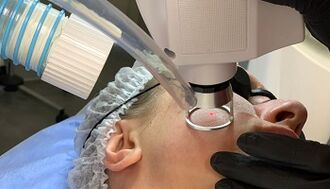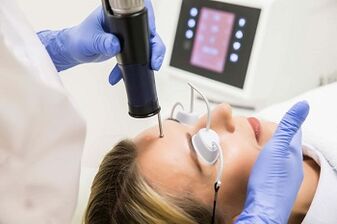
Aging is a natural biological process that affects all tissues of the human body. It is especially susceptible to those parts of the body that make up a person's appearance.
For example, facial tissues are constantly exposed to environmental factors, as well as facial functions, chewing and speech.
The issue of preserving the youth of the person is very important and relevant, because it is a kind of "business card" of a person.
Today there are many methods to solve this problem, but laser facial rejuvenation, according to reviews, deserves special attention.
The mechanism of action of the laser on the skin
The essence of the method is the fractional effect of a laser beam on the skin. The laser beam, splitting into very, very thin beams, affects microscopic areas of the skin and evaporates them. The laser zones are located at a strictly defined depth. The intact cells located between the areas of exposure to the laser beam begin the active production of two main "building materials" - elastin and collagen, because with age these substances in the human body virtually cease to form independently.
After the laser facial rejuvenation procedure, the skin color improves, the bags under the eyes are removed, medium and fine wrinkles disappear or are corrected, the contour of the face is tightened. In addition, this method is used to improve the results of surgical intervention (for example in plastic surgery), as well as for laser skin repair.
Types of fractional laser facial rejuvenation
Depending on the depth and nature of the penetration of the laser beam into the skin, there are two types of procedures:
- Ablative fractional laser rejuvenation, when micro-areas of the skin are removed and then, in the process of gradual healing, the damaged microzones are tightened. The lifting effect is noticeable after the first procedure;
- Non-ablative fractional facial rejuvenation, when collagen and elastin are also renewed in the damaged area, but the processes take place in the deep layers of the skin, into which the laser beam penetrates without damaging the outer layers. As a result of this procedure, the rejuvenation process is longer.
The optimal variant of the technique can be suggested by a specialist, but according to the examinations with laser facial rejuvenation it is most effective to combine different types of procedures so that the renewal of the cells is performed not only on the skin surface, but also in more -deep layers.
The benefits of fractional laser facial rejuvenation
Fractional laser rejuvenation, compared to the classical method, has a number of advantages.
First, the effect on the skin is accurate, which means that its damage is minimal. Due to this, all traces of the procedure disappear in 3-4 days after the intervention.
Second, within one session it is possible to treat large areas of skin, while its regenerative resource is not only preserved but also activated, which ensures rapid rehabilitation and long-term positive effect.
Third, the procedure does not require anesthesia and can be easily performed on the skin in the area of the décolleté, neck and eyes.
And fourth, side effects are rare. Possible complications in the form of red spots in the area of action, mild itching, flaking, burns or crusts on the skin quickly disappear. Scars, hypo- and hyperpigmentation are extremely rare.
Despite the listed advantages, before performing the procedure, it is necessary to get acquainted with the indications and contraindications for laser facial rejuvenation.
Indications for laser rejuvenation
During its existence, the method has proven its effectiveness, but its effect will be especially noticeable in the case of the following skin problems:
- Spider veins;
- Scars;
- Stretch marks;
- Enlarged pores;
- Pigmentation;
- Acne;
- Wrinkles;
- Loose, sagging, fading skin;
- Put your feet around your eyes.
If any problem from the proposed list is relevant, fractional laser facial rejuvenation will help to deal with it.
Contraindications for laser facial rejuvenation
In addition to the obvious indications, there are absolute contraindications to the procedure:
- Inflammatory process in the affected area;
- Dermatoses and psoriasis;
- Propensity to form tumor scars;
- Herpes outbreaks in the affected area;
- Cases of vitiligo in close relatives;
- Chemical peeling performed less than 2 weeks before the proposed procedure;
- Systemic blood diseases;
- Varicose veins in the laser area;
- Pregnancy and lactation;
- Oncological diseases;
- Severe forms of coronary heart disease and hypertension.
Relative contraindications for laser facial rejuvenation are the presence of fresh complexion, medium and superficial peeling less than 3 weeks before the procedure.
Laser rejuvenation course and actions after it

Depending on the area of the treated skin and the nature of the problem, the duration of one session of fractional laser exposure is from 20 to 40 minutes. Repeated procedures are only possible after 3 or 4 weeks, and generally 3-4 sessions are usually required. Within three months after completing the course, the maximum positive effect is observed. To maintain it, it is recommended to do repeated sessions once a year.
After the procedure you may feel a slight burning sensation, but it disappears after about 1-2 hours. The resulting redness and possible slight swelling last 1-3 days. At this time, the use of external agents that contain depanthenol (eg ointments or gels) is recommended. As soon as the listed symptoms disappear, it is necessary to use a cream containing hyaluronic acid.
You can wash and take a shower on the same day as the laser facial rejuvenation, but it is better to postpone the visit to the pool or sauna. One day after the procedure you can use the foundation again.
The use of sunscreen with SPF 30 or higher is mandatory, as at this time the skin is particularly sensitive to UV rays.
After laser rejuvenation, you should follow the recommendations of the specialist who performed the procedure. The doctor, depending on the type and characteristics of the skin, will suggest the optimal cosmetics, as well as determine the frequency and duration of their use.
























